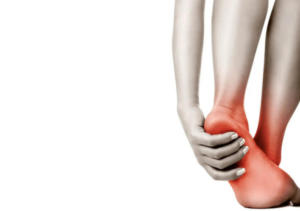Heel pain is a common foot condition characterized by discomfort or pain in the heel area. It can affect individuals of all ages and may vary in intensity from mild discomfort to severe pain that interferes with daily activities.
Causes of Heel Pain
- Plantar Fasciitis: Inflammation of the plantar fascia, a thick band of tissue that connects the heel bone to the toes.
- Achilles Tendinitis: Inflammation of the Achilles tendon, which connects the calf muscles to the heel bone.
- Heel Spurs: Bony growths that develop on the underside of the heel bone, often associated with plantar fasciitis.
- Stress Fractures: Small cracks or breaks in the heel bone due to repetitive stress or overuse.
- Bursitis: Inflammation of the bursa, small fluid-filled sacs that cushion the joints, commonly affecting the heel.
- Sever’s Disease: Heel pain in children and adolescents due to inflammation of the growth plate in the heel bone.
- Footwear Issues: Wearing shoes with inadequate support, poor cushioning, or improper fit.
- Overuse or Injury: Prolonged standing, walking, or running, or sudden impact injuries.

